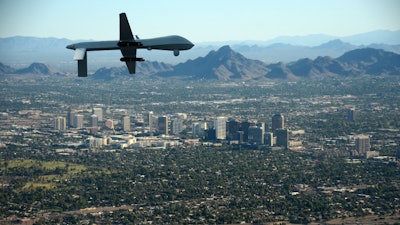
Unmanned aerial vehicles (UAVs) are invaluable in today's military and civilian initiatives. However, most unmanned systems are being designed to execute the long-running mission. Thus, it is necessary for UAVs to return to base for refueling. Under this circumstance, autonomous aerial refueling (AAR) becomes an important capability for the future employment of UAVs.
Vision-based sensor and navigation systems are widely used in AAR, while experiments are done for both probe-and-drogue refueling systems and the boom approach.
Researchers in China, via grants from the National Natural Science Foundation of China and Aeronautical Foundation of China, have developed a platform aiming to realize the real-time simulation of AAR in mid-air. They used an octocoptor as the tanker UAV and a hexacoptor as the receiver UAV. When the receiver arrives at the visual field of the cameras on the tanker (about five meters), the binocular vision system kicks in to capture the connection on the receiver.
The on-board next unit computing (NUC) processes the images and estimates the position of the receiver. Then the visual information obtained from the vision system is transferred to the flight controller and boom controller to control the flight of the UAVs, as well as the movement of the boom towards the receptacle.
The binocular vision system consists of two primary procedures: feature extraction and pose estimation. The pixel coordinates of red markers painted on the receiver UAV are generated after feature extraction. The generated pixel coordinates are utilized in the position estimation process. The estimation procedure is exploited to calculate the relation matrix between the binocular vision system and marker coordination system.
To verify the effectiveness of the vision algorithm of the boom approach in AAR, researchers developed a mimical refueling boom system. After achieving the frame sequences of the marker on the receiver, the next unit computing (NUC) mounted onboard conducts the position estimation. An arm microcontroller obtains the results, and figures out the control level to control steering engines. The refueling boom will point at the receptacle in the resolved position and implement the connection.
A series of out-door flight tests are being conducted in various environments to verify the feasibility and effectiveness of the platform.






















